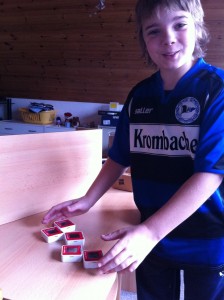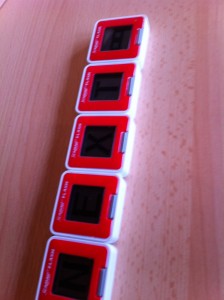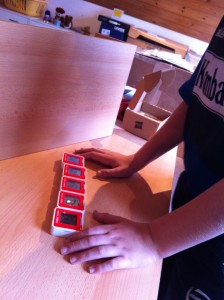This is the fourth part of a series of blog entries on a gift I got from Matt Heusser. Today, I’m heading for multiplayer games with our 11 year-old who has just same basic knowledge about English words.
As I started to prepare for this session, our 11 year-old, Leon, entered the room to play a bit on the computer of my wife. I asked him if I could use his service as a real usability tester of the product, and he agreed. Here you can see him in action.

We headed for the multiplayer game variant 3. The rules are simple. You get five letters, and some seconds to form a word out of them. If you achieve this, the next player takes turns. If you don’t, you’re out, the word is displayed, and the next player takes turn. If you’re the last player, the game is over. With every new round, you get less and less time.
That’s it.
Now, we went for our session. I explained Leon the rules of the game, and we started. Keeping in mind there are variants of five and four letter games, we started with five letters, and changed that later to four letters. Interestingly it was no possible to change within the game from a five letter to a four letter game, but it was impossible to change from four to five letters back without getting the main menu, and starting all over.

Leon claimed afterwards that the four letter game was easier, as there seemed to be easier words for a foreign speaker. I had the same experience the last time I played with the game, and it felt the same now as well.
We played a bunch of rounds. We didn’t timebox it. Timeboxing with kids is difficult and easy at the same time. Once they get bored, you’ll know that the game is pretty dull or they’re demotivated. If they keep their attention, you’ll have hard problems ending the timebox. Overall we used roughly half an hour to experiement with the product.
On usability, I agreed with Leon to help him with his turns. The five letter words seemed too hard to find for him – and even for me at times.
As the game started to bore us, we tried to measure a claim. The timing should decrease over time. So we started to notice whether the time we had to arrange the tiles was actually feeling to decrease as we played. After playing 20 or so rounds, we didn’t notice that the time got shorter and shorter. At that point we started to try to actually measure the time we got left.
We found that we were having 10 seconds left at the point we started to measure. After a while this had come down to roughly 8 seconds, but didn’t seem to decrease any more. After the session we formulated the hypothesis that the time just decreases if you find a word in the time. If you get thrown out, nothing happens. We didn’t validate this hypothesis, so I put it down on my todo list for next time.
We also wanted to know how much time we have in the first round, and how much it decreases in each round. Now, there were some measure inconsistencies based on reaction times, and the like. We found the first round, we got roughly 21 seconds, and it seemed to decrease for one second each round.

There were two more things that were interesting in this session. First, Leon claimed there is an ad for the game on German TV as well. So it seems there is a German version of the game. I’d like to see how this one works compared to the English version. We could also run the German through someone with English as primary language. Nothing I may achieve over the holidays, but something for the long-run.
The second thing is we accidentially achieved to break the game, and had to reboot it. We couldn’t reproduce the problem afterwards, though. We played around with removing a piece once the time was up, and the word was going to be displayed. Removing one tile at that point led to a stall up until I put the tile back, and the word was displayed again. The same happened for the “out” message. In one game we passed the game to the other played, maybe accidentially removing one piece thereby, the game got stalled, and we couldn’t bring back the game to a normal, unstalled state. We tried to reproduce that, but didn’t achieve it. This is a situation where I missed video recording of what we did, in order to reproduce our behavior.
In the next and final blog entry in this series I am going to head for the timing, and taking a closer look on the inner live of the tiles. I also want to see that ad on German TV. So, stay tuned for the next entry.
One thought on “A Christmas gift from a tester for a tester – Part Four”